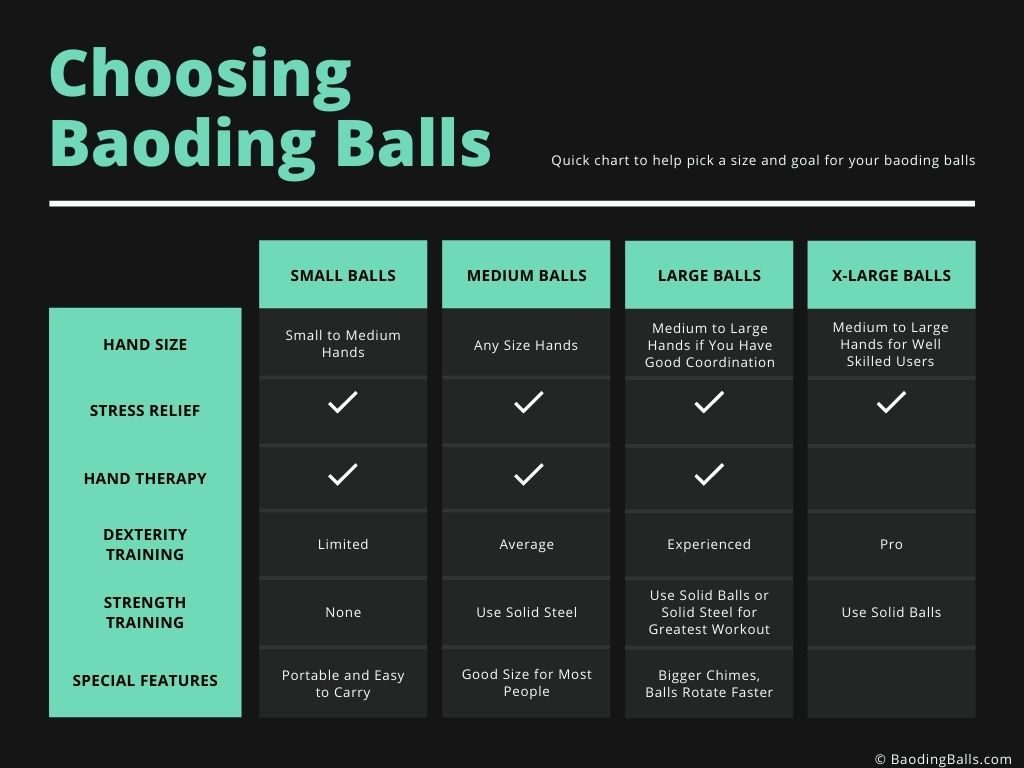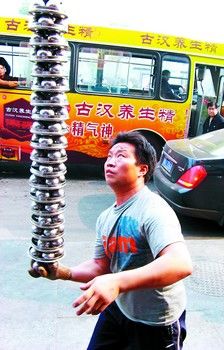Selecting your baoding balls depends on a few main factors including your hand size, skill level, and goal for using them. You can use this chart as a suggestion of what size you may want to look for.

The measurements of each size will vary between a range. This is because the balls are hand made and balls with enamel on them add to the thickness of the ball compared to plain steel balls.
Choosing the Size (Diameters are of 1 Ball)
Small: 1 – 1.46 inches (25 – 37 mm)
Small sizes are suitable for children as well as adults. They are easy to keep in your pocket like a pocket sized baoding ball set to keep with you. Women with small hands will also find the small size easier to work with. People using baoding balls to rehabilitate hand injuries should also start with small size balls because they are easier to manipulate, but the small size is not good for someone looking to spin them fast because they are very light.
Medium: 1.5 – 1.65 inches (38 – 42 mm)
Medium sized balls are the most popular and common size. Medium sized balls are a good choice for women and men. They can be rotated touching for beginners and not touching for more skilled users. It is a safe size if you’re buying them as gifts because everybody can use this size.
Medium-Large: 1.75 – 1.85 inches (45 – 47 mm)
Moving up to the medium-large size will feel slightly bigger than the medium size. If you are a person with larger hands, this is a good option. This size baoding ball will feel fuller and extend your fingers more to work with them.
Large: 2 – 2.1 inches (50 – 52 mm)
When you have become proficient with baoding balls, you will want to move to the large size. This size will fill up your whole palm for most adults. Two balls are about 4 inches long when touching. The hollow large balls are easier to rotate fast for dexterity training due to the large surface of the balls. Solid balls provide greater weight for grip and strength training. Larger balls can roll across your extended fingers letting you rotate them in a larger circular motion while small balls would fall between the gaps. Large chiming balls have a better sounding chime as well because the chime inside is bigger and produces a more resonating sound.
X-Large: 2.2 inches (55 mm)
Same features as the large size but even bigger.
XX-Large: 2.36 – 2.6 inches (60 – 63 mm)
Not a very common size, but people do use this size to really stretch their fingers out.
Choosing Hollow vs Solid Balls
Hollow balls are better suited for dexterity and coordination training due to the light weight. They can be used for longer times before getting tired and can be rotated quickly or slow for meditation. Hollow balls can have chimes or without chimes.
Solid balls are better suited for exercising your hand muscles. When made of stone, they are light enough for dexterity training as well. Solid steel balls are heavier and really target strengthening the hand and forearms. The small to medium solid steel balls provide a balance of exercise training while not being too heavy for improving dexterity. A good feature of solid balls is they will not disturb people around you that chiming balls might do.

In summary, determine what your goals are for using the balls and pick a size to match your skill level and hand size. So if you want something to casually use for stress relief at the office while exercising to prevent work related hand problems, a medium solid steel set should work well. The elderly wanting a gentle way to improve hand control at home or on a walk can use a hollow small or medium size baoding ball. In contrast, a rock climber may want to use a large solid heavy set of balls for hand strength while a piano player may want an extra large hollow set for finger dexterity.
The sizes and types of baoding balls are versatile to fit your needs. With practice, you will see improvement in your goals as well as your health. All sizes of baoding balls will increase blood circulation in the hands and chi flow in your body. Collect all the sizes and don’t worry about being limited to one type!




































